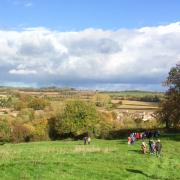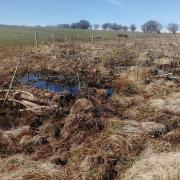Craftsman Neil Hopkins makes fine art paper in a 400-year-old water mill photography: John Lees
Walk along the River Washford on the northern edge of the Exmoor National Park and you’ll find Pitt Mill. This 400-year-old watermill has been restored and is now the home of Two Rivers Paper Company. Although the mill machinery is now rarely used as a power source, the building contains a range of traditional paper making equipment, including an 1841 Hollander Rag-Breaker.
Two Rivers was established in 1976 and is currently run by Neil Hopkins – one of a small number of artisans across Europe still producing watermarked fine art paper. The paper has a strong following amongst both professional and amateur artists because of it achieves a random surface texture totally unlike the mechanical weave found in machine-made products.
This robust paper is ideal for a wide range of media and Neil’s studio wall is covered with paintings from the many artists who prize his paper. There are examples of pastel, oil, printmaking and photographic processes, but Two Rivers paper is particularly popular with watercolourists, who enjoy the almost magical luminosity of the paper. This is achieved by external sizing with gelatine, which encourages pigment to sit on the paper rather than soak in.
National Trust property Barrington Court, near Ilminster, recently hosted an installation by artist Maeve Clancy highlighting the house’s links to the Arts and Crafts movement, featuring huge cut-out displays all made from Neil’s paper.
The techniques used to make the paper are ancient, and Neil talks me through them as he makes a batch, a two-day process from start to finish. Cotton rag and linen are macerated in water and hours later a tankful of this porridge-like liquid is given a final stir by Neil with a bright yellow canoe paddle before he dips the mould into the vat. The hardwood mould he uses is made by a Kent craftsman, fitted with a fine phosphor bronze mesh. Around this is a wooden frame – the deckle – which forms the distinctive ragged edge of handmade paper. The poster-size sheets Neil makes require a large mould, powerful shoulder muscles, and the willingness to stand on a cold wet floor for hours on end to produce each batch.
Once the mould is lifted from the mix the surplus liquid falls away, and from here the process is all about water removal – by vacuum pump, by an imposing red press, then between blankets of felt. Finally the sheets are hung on racks raised by pulleys, glass balls gently holding each sheet in place. The racks fill the roof space like the upper masts of a sailing ship.
Neil is a skilled craftsman and great raconteur, happy to explain the history of paper, an art going back thousands of years, long before the days of cheap paper made from wood pulp. The techniques he uses have been handed down from one maker to the next, and as Neil demonstrates the process of ‘couching’ (laying each piece flat and then bedding it between felt sections) you realise how few people retain this knowledge. No wonder he describes himself as ‘last man standing’, one of the few who retain expertise passed down from former generations of handmade paper specialists.
Watching the painstaking process from liquid to packed products, you quickly understand that this is a vocation, not a business. Every sheet is a unique craft product.
All Neil’s papers are produced to archival standards, which means they will last centuries longer than wood pulp paper. Producing no more than 120 sheets of paper a day, Neil Hopkins at Two Rivers reflects a slow, careful Somerset art.



























